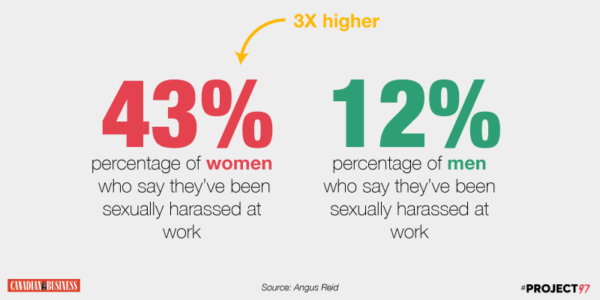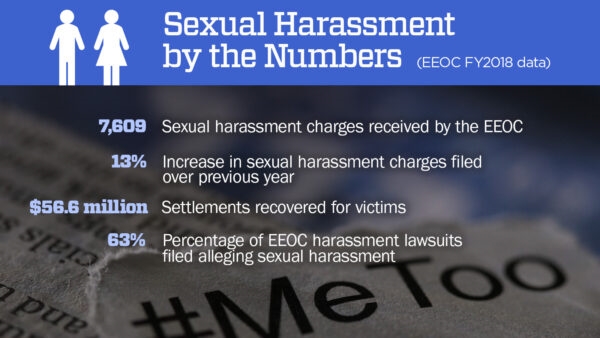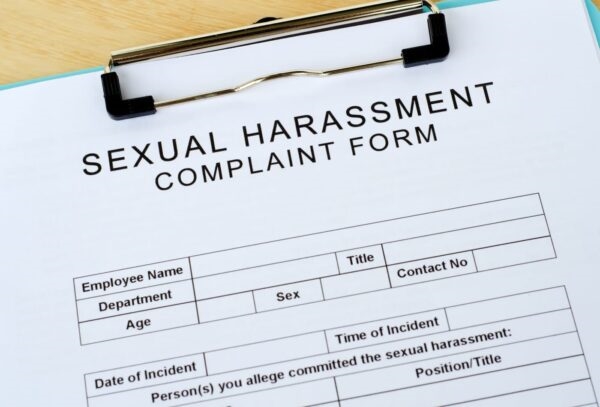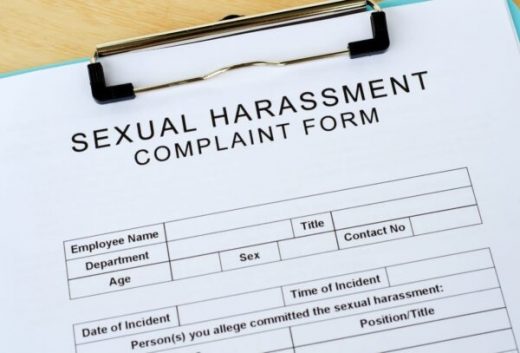How to Respond to Sexual Harassment or Racial Discrimination Allegations in the Workplace
Dealing with sexual harassment and/or racial discrimination in the workplace can be a terrible time in a person’s career. That’s why understanding how to respond to this situation correctly is crucial for any company.
Businesses that do not have this knowledge or dismiss the importance of such allegations – deliberately or unwittingly – can face lawsuits, brand damage, and employee dissatisfaction.
Research shows that:
– Over 70% of BAME employees have been subjected to racial discrimination.
– Over 30% of BAME employees have been mistreated due to their race.
– Over 40% of BAME employees that complain about poor treatment are dismissed or ignored.
– Over 20% of US employees have faced sexual harassment in the workplace.
– Almost 30% of sexual harassment cases go unreported due to the complaining party’s fear of dismissal or retaliation.

These statistics prove that, sadly, sexual harassment and racial discrimination are often prevalent in the workplace. In this article, we’ve compiled the most effective ways that your company can respond to these allegations.
But first, let’s start with some definitions.
What is sexual harassment?
The term ‘harassment’ is used to describe either verbal or physical behavior that’s hostile. Harassment can intimidate, offend, and affect the productivity and well-being of the victim.
Sexual harassment can include inappropriate advances, verbal requests, physical contact, and even written, graphic material of a sexual nature. Sexual harassment in the workplace, whether in a physical setting or in the digital sphere through personal or workplace messaging applications similar to slack, can make the victim feel helpless and believe that if they do not comply with these sexual requests, their career will be hindered.
Both men and women can be subjected to sexual harassment, and often, the sexual harassment complaint may come from a third-party witness. It’s also important to understand that sexual harassment can happen between any employees, regardless of position, and also between a customer and an employee.
Not only this, but sexual harassment in the workplace can include inappropriate sexual conduct outside of normal working hours, such as at company events.
There are two common types of sexual harassment in the workplace:
- Quid pro quo harassment. Employees can only conduct this type of harassment in senior positions. It involves asking for a sexual favor in return for a career-based favor such as a promotion or increased pay.
- Hostility in the workplace. This is when an employee carries out sexually related verbal or physical conduct that makes carrying out a job increasingly difficult.
Here’s a common scenario. A new employee asks an established employee a question such as “what does excellent customer service look like?”. Instead of simply assisting, the established employee uses this opportunity to make unwelcome sexual advances.

What is racial discrimination?
Racial discrimination is the process of distinguishing, excluding, or restricting an employee based on nationality, ethnicity, immigration status, or color. It’s the unfavorable treatment or disadvantaging of an individual due to their race, and it’s against the law as outlined in the Anti Discrimination Act.
Racial discrimination can come in many forms. Here are the two most common ways racial discrimination can occur in the workplace:
1. Directly discriminating. This is when an employee is directly targeted and treated poorly because of their race or perceived race. Racial discrimination can even be committed against individuals who associate with the victim. This is known as racial discrimination by association.
It’s still considered racial discrimination whether it’s a one-off incident or constant hostility. Direct discrimination can be subtle. For example, say an employee hosts a seminar with the title “how to send a fax from the internet”.
Instead of focusing on the content, some employees dismiss the presentation due to the title’s grammatical error and racial stereotypes surrounding education and intellect. This is a form of racial discrimination.
2. Indirectly discriminating. This occurs due to a deep-rooted issue in company policy or practice. A common example is when a business accepts specific qualifications that can only be achieved in one country. This means potential candidates from other nationalities cannot be hired.
If you ever find yourself in a situation where you need to respond to a sexual harassment or racial discrimination allegation in the workplace, you should be fully equipped with the correct tools and knowledge.
In these next sections, we’ll discuss the best practices for responding to these specific types of allegations to ensure that your company handles them correctly.
Do you need legal assistance?
As mentioned above, employers and business owners have a legal obligation to address and handle both racial discrimination complaints and sexual harassment allegations. Even though most company owners want to do what’s best for their employees, they often don’t have the legal know-how to understand how best to deal with this situation.
This is why you should treat it like a court case as soon as a complaint arises. Companies that do not take harassment or discrimination allegations seriously can face liabilities and damages that exceed simple compensation.
Various legal complications can arise from these types of complaints that your company supervisors or human resources (HR) department will not have the legal knowledge to handle.
A common example is when an employee asks the HR department to keep a specific complaint about the work environment confidential. If this complaint is related to sexual harassment or racial discrimination, then from a legal standpoint, it cannot be kept confidential.
This is why a lawyer needs to be present to explain why the company is required by law to address the complaint. Without the presence of a lawyer, the complaining party may accuse the company of being untrustworthy. This can damage the company’s reputation.
Here are some of the main benefits of hiring discrimination and harassment lawyers:
- Attorneys can provide anonymity. Hiring lawyers reduces the number of people the complaining party has to interact with about the allegation. This means the lawyer can inform the board of directors of the allegations while ensuring the complaining party’s identity is kept hidden.
- Time management. Lawyers can reduce the amount of time and resources a business spends on an allegation case. This is because they can provide reliable advice, review internal policies, deal with the complaint, and prevent costly legal fees.
- Provide employee training. Discrimination and harassment lawyers are incredibly well versed in discrimination and harassment law. This means they can help your company create better policies and standards to prevent situations like this from occurring in the future. Not only that, but they can provide training to your employees to ensure everyone understands the new practices put in place.
What should you do immediately?
Making a formal complaint about either sexual harassment or racial discrimination can be a nerve-wracking process. This is why it’s crucial to handle the allegations with care and respect. This is one of the crucial business processes that every company should observe.
One of the biggest difficulties companies face is striking a balance between ensuring confidentiality and showing the company does not stand for this type of behavior. Of course, you shouldn’t broadcast the news throughout your company departments, but you should act quickly to make the complaining party feel like the situation can and will be resolved.
After the allegation is made, the most important step that needs to occur is the immediate termination of either the harassment or discrimination. This is done by ensuring no interaction between the complaining party and the alleged offender.
Protecting the accuser
Harassment and discrimination can be either a one-off incident or persistent hostility. This is why you must inform both parties that any contact after the allegation and during the investigation could result in further damages.
To ease this process, employers have a variety of options:
- They can have the offender write a letter of apology.
- They can ensure the two parties are not working closely by moving them to different company projects or areas.
- They can give the complaining party the option of paid leave during the allegation process.
- They can suspend the accused party until the results of the investigation are released.
Listening to employees and ensuring their continued well-being should be the company’s priority. Statistics show a company that listens to its employees is almost five times more likely to reach their maximum productivity potential.
This is why it’s always good to understand early on how the complaining party hopes to be compensated. Your company isn’t obliged to carry out these requests until the investigation is complete, but it can be useful in helping resolve the case at the conclusion stage.
Being retaliated against by either the alleged discriminator or even the company itself is a common fear among individuals who make a complaint of this nature. Statistics show that around 75% of people who speak out about harassment or discrimination in the workplace face a form of retaliation.
This is why it’s your duty as the employer to let the complaining party know that this will not happen. Retaliation can be a reduction in pay, position, or even suspension. But it can also be smaller acts.
For example, let’s say that, before the allegation, the complaining party was working on a big project with the alleged offender. Moving the complaining party to a project with less importance could be regarded as company retaliation. Retaliation can result in liability for you as the business owner.

What are the investigative practices?
The investigation is the most important stage of any sexual harassment or racial discrimination allegation. Your response will set a precedent for how your company deals with these sorts of situations.
Failure to fully investigate and/or collect valuable information may result in the case escalating further. If bad investigative practices are found, companies can face both punitive and emotional distress damages.
Hiring an investigator
If you feel like there is no one capable of carrying out an efficient and unbiased investigative process, it’s often wise to hire a specialist investigator. Investigators are impartial, have sufficient legal knowledge, and are trained to discuss sensitive subjects with people in a respectful manner.
Essentially, the investigator will handle the process from start to finish, using your company policies to guide their decisions. One of the most important things to look out for if you hire an investigator is that they may not be up to speed with some of the company jargon that may be useful to their investigation.
For example, let’s say the harassment or discrimination took place over an office phone service with a call controller or a virtual online network such as VoIP. Your investigator may be well-versed in sexual harassment law, but their knowledge about cloud-based communications might be limited. This is why you must provide them with answers to specific questions like “what’s VoIP?” and/or “what is a VoIP phone service?”.
Investigating internally
If you decide instead to carry out the investigation yourself or within your company, using a suitable individual, there are a few things you need to consider.
Each investigation is different. Figuring out the scale of the investigation should be your first step. You should be attempting to find out answers to questions such as:
– How many people are involved?
– Where did this action take place?
– How long has this been going on?
This leads to our next point. These types of investigations require you to carry out interviews. You should interview the complaining party, alleged offender, and other witnesses if required. It’s important to make sure all the information the parties provide is only analyzed by a predetermined, unbiased counsel.
From the first moment the complaining party walks into your HR department, keep a record of everything, continuing with this until well after the conclusion stage. Everything people say, do, and the specific actions you’ve taken.
This documentation is useful for a couple of reasons:
- Protecting yourself. Keeping a record of the actions you’ve taken provides evidence that you have done everything in your power to address and handle the allegations. This will serve as proof if either party seeks legal compensation.
- A well-organized investigation. Documenting the statements taken from all parties will allow you to come to an accurate conclusion. These types of investigation are often “his/her word against mine” scenarios. By storing such information, including dates, times, and witness statements, you can more easily spot inconsistencies and fabrication. Some of the best employee management software out there might also help you gather information to corroborate the different parties’ various statements.
What should the final stage be?
The final stage or conclusion of this process is split into three parts: the analysis, the results, and the report. Even if a full and proper investigation was carried out or a highly-skilled investigator was acquired, the final stage can still be complicated.
1. The analysis
Once you have collected all the data and evidence, you should then filter out any irrelevant information. This is information that doesn’t directly tie into this particular case. But it’s important to still keep a record of these unwanted/irrelevant statements or facts.
Following this, you then need to check the credibility of the useful information. This means ensuring there are no obvious contradictions between the same person’s statements and creating a detailed timeline of all events.
2. The results
Whether you’ve hired an investigator or are carrying out an internal process, the results procedure should revolve around the same principles. This outcome should therefore be based on what the current company policy states, the act committed, and what disciplinary action this requires.
For example, let’s say the investigative evidence concludes that an inappropriate comment was made. You should then check company policy and carry out the predetermined consequence, such as installment of a block messages and calls app, suspension without pay, termination, sexual harassment in the workplace training, or counseling. Regardless of whether a conviction is made, it’s beneficial to provide additional company policy training for all employees.
It’s also important to let the parties directly involved (not the witnesses) know about the investigation’s results. This will consist of one of three statements: the burden of proof has been satisfied, the burden of proof has not been satisfied, or the results are inconclusive.
In addition to this statement, companies should provide a summary of the investigation, the company policies, and (if applicable) the disciplinary action.
3. The report
A well-written, clear, and concise discrimination or harassment in the workplace report is a key part of the process. This will serve as evidence if the case is taken to trial, but it will also show that your company takes allegations of this nature seriously and handles them appropriately.
The report should consist of a variety of elements:
- A general outline of your company.
- A summary of your HR department practices, such as its size and whether or not you use human resources software.
- A summary of the allegations.
- Whether or not the investigation was carried out externally or internally and a detailed description of the evidence found.
- How credibility checks and your analysis took place.
- A summary of the conclusion and action taken based on company policy.
How can you prevent this from reoccurring?
Whether you’re a small business that provides TCPA compliant dialer tools or a leviathan like Amazon, sexual harassment and racial discrimination are possible in the workplace.
Responding to allegations is a sensitive, time-consuming, and expensive process that can lead to legal liability if handled incorrectly. It is almost impossible to fully prevent discrimination and harassment from occurring in the workplace, as this is a society-based issue.
But companies can clamp down and mitigate their occurrence by creating and constantly revaluating their anti-harassment and anti-discrimination policies.
Here’s a checklist of components you can use to create a robust anti-harassment and anti-discrimination policy:
- All statements should be communicated in simple terms that employees of all nationalities can comprehend.
- An easy and confidential reporting system should be in place that allows anyone of any position to report anyone else without fear of retaliation. This should lay out how the company will respond and how long this will take.
- An assurance that all information or allegations conducted will be kept anonymous and confidential to the best of the company’s legal ability.
- A clear description of potential offenses that can occur. This should include verbal, physical, virtual, direct, and indirect actions.
- A clear description of the appropriate disciplinary actions based on the offense committed.

In conclusion
Dealing with sexual harassment or racial discrimination allegations can be a difficult time for any company and, most importantly, the potential victim. If mismanaged, companies can be held legally responsible, which can damage the reputation of the brand and significantly reduce employee satisfaction.
This is why companies must have the knowledge and expertise to both prepare and respond to a situation of this nature. Let’s quickly recap the points mentioned above:
– Sexual harassment and racial discrimination in the workplace cases are a legal minefield that can be difficult to navigate. This is why hiring a legal team and treating the allegation like a court case is a sensible option to ensure your company doesn’t face legal repercussions in the future.
– Your immediate reaction to an allegation sets a good response apart from a bad one. This is a sensitive issue and should be treated with appropriate care and empathy. The most important thing is to stop the harassment or discrimination, separate the parties, and ensure no retaliation can occur.
– The investigation stage can be carried out by an expert investigator or internally. But, regardless of who conducts it, investigations should be thorough, and all the information collected should be recorded and kept on file.
– Reaching a suitable conclusion can be difficult if the evidence is inconclusive. Any disciplinary action decided should directly relate to company policy. Creating a report provides evidence that you have correctly responded to this situation.
– A clear, concise, and comprehensive anti-harassment and anti-discrimination policy is necessary to reduce the number of allegations that take place. Companies should learn from this process and make the necessary adjustments to their existing policies, ensuring all employees are kept up to date with these changes.
Business & Finance Articles on Business 2 Community
(36)


